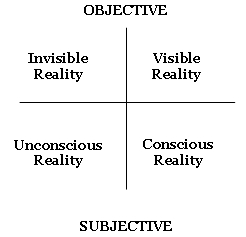The Different Flavors of Reality ~ Where Do Creative Ideas Come From?
I may lose a few folks with these opening comments but to really "get" this post you should first read this one and then read this one. They'll open in new windows so you can pop right back here… I totally recommend you read the comments on those posts, too. Seems our regulars are getting into the spirit of things :-)
For those who haven't read those other posts, I'll face the challenge of writing a synopsis:
Writers seem like strange creatures, always coming up with make-believes that seem real, talking to characters in their heads, spending lots of time absolutely alone…
Seems we writers are actually like other people but more so…
Writers use something everyone has but they use it more.
I'm going to insert an image, but first want to credit the man from whom it was adapted, William S. Hatcher. I found the diagram in his book, Logic & Logos. I should mention, mostly because the image implies it, that the theories of Carl Jung support Hatcher's ideas.
MAP of REALITY
First, notice that Unconscious Reality and Conscious Reality are both Subjective: they are what each individual has "within" them…
Then, Visible Reality and Invisible Reality are both Objective: "outside" the individual…
Now, a little explanation of each flavor of Reality:
Conscious Reality: This is what far too many people think is the only reality. It's the Ego-consciousness, the part of the mind that sees objects, the place where we do our thinking and shout in silence…
Visible Reality: This is the world-out-there. Again, far too many people think this is the only reality that's outside their mind–if ya can't see it, it ain't real…
Invisible Reality: This flavor of Reality might sound totally strange but contemplate gravity–can't see it but you definitely know it's there. Magnetism is another part of Invisible Reality. And, if you really want to grasp this aspect of Reality, realize that most of what we call Social Reality–institutions, corporations, various civic offices–are also part of Invisible Reality. Sure there are Visible buildings and corporate headquarters and mayors but the concepts of institution, corporation, and office are truly invisible. There may be a President in the White House but you can't actually see The Presidency…
Unconscious Reality: Now we're into the area of Reality that writers (and any creative person) use so much. This is internal to a person. Most people don't pay conscious attention to this part of their mind. It makes itself known, whether a person wishes it or not, in dreams, day-dreams, sudden speech we often wish hadn't left our mouths, and other interesting manifestations.
The Unconscious Mind of each individual is also, apparently, connected at its deepest levels with what might be called the Memory of Humanity–the Collective Unconscious–but this memory isn't passive; it has energy and purpose and has powered many a fine conscious idea…
For more info on this rich reservoir of creative potential, read this.
So, to summarize:
There are, at least, four realms of Reality and two of them are inside us. Most people cling to their Conscious Reality and shun the Unconscious. They leave themselves open to bad dreams, embarrassing social gaffs, troublesome relationships, and even increased illness…
Writers (and other creative types) take advantage of their Unconscious Reality. It either flows up to the conscious mind without bidding and is accepted as a resource for creativity or they work to make it manifest its images and energies.
I hope you read those two earlier posts I recommended and it would be just fantastic if you've checked out the other links. Now, I will eagerly anticipate the continuation of the conversation from the earlier posts' Comments………
~~~~~~~~~~~~~~~~~~~~~~~~~~~~~~~~~~~~~~~~~~~~~~~~~~~~~~~~~
Our Comment Link Is At The Top of The Post :-)
Follow the "co-author" of Notes from An Alien, Sena Quaren:
On Facebook
On Twitter
AND, Get A Free Copy of Our Book
Tagged: artist, Carl Jung, Consciousness, creativity, Reality, Unconscious mind, William S. Hatcher, writer








 newest »
newest »
 Wow!! Glad we can connect here, too :-)
Wow!! Glad we can connect here, too :-)




